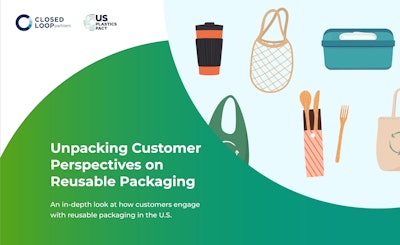
Closed Loop Partners’ Center for the Circular Economy, in collaboration with the U.S. Plastics Pact, has published a report titled “Unpacking Customer Perspectives on Reusable Packaging”, which contains insights on U.S. consumer behavior with respect to packaging reuse in the U.S. The data is intended to help key stakeholders–such as brands and retailers–in decision-making capacities around reusable packaging implementation techniques on their journey to making reusable practices a part of everyday life.
Closed Loop Partners and U.S. Plastics Pact hope the report “inspires companies, brands, policymakers, and others to consider reusable packaging systems through the lens of the customer and will serve as a source of inspiration to spark conversations.”
You can access and read the full Closed Loop Partner’s report for free.
The report is based on data pulled on current consumer habits and actions rather than sentiment and can be summarized with five key insights.
 | The Case for Concentrates in Smaller Packs in the Era of Shrinkflation |
Consumer education and employee involvement
First, the report says that consumer understanding of how reusable packaging systems work is integral to their successful integration. Effective education and communication strategies should be implemented throughout the entire reuse process in order to guide the consumer through the various stages involved, from collection and cleaning to redistribution. The report suggests persistent and strategic communication at various touchpoints within the reuse loop. For instance, for reusable packaging systems that involve retail return, retail employees should be trained on the reusable packaging process so they can help inform consumers on how to navigate the reusable packaging system. Also important is electronic communication via emails or in-app reminders when a reusable packaging system uses a smartphone app. More generally, educational campaigns on reusable packaging should be broad and use analog messaging as well, relying also on in-store signage in retail return schemes, and labels on the packaging itself.
Multiple educational channels and interactive moments between consumers and the system itself, including retail employee interactions, are crucial for creating awareness among consumers of how a reusable packaging system works. Pilots tested to generate insights for this report revealed that employees' responses to questions significantly influence customer behavior. The report also states that “communication should present reusable packaging as an easy way to reduce single-use plastic. It should break the process into simple steps like “Buy”, “Use” and “Return.””
Technology-enabled reuse systems
Technology can generate usage data and impact metrics that could provide insights that would help in reuse operation optimizations. If they are to be adopted, technology-enabled reuse systems must balance the backend technological capabilities with a simplified, streamlined frontend user experience, making the system manageable for all users. The report explains that a system is more easily accepted when it minimizes customer friction and perceived inconvenience or extra effort, which includes removing extra steps the consumer would need to take.
While technology plays a vital role in the backend, providing valuable insights through usage data and impact metrics, to drive adoption, the enrollment process must remain simple, intuitive, and quick for consumers. To prevent frustration and abandonment, technology integration should be reliable, accessible, and designed to be simple and intuitive.
Packaging material and design
Effective design is crucial for the success of reuse systems, as consumers may not always return their reusable packaging. This involves using package design to solve for both the physical product and its surrounding packaging ecosystem, with a package design focus on usability, sustainability, visual appeal, ergonomics, and ease of reuse.
Usability is maximized when the packaging is durably constructed yet lightweight for easy transport and storage. Material choices play a role in accessibility, considering that premium materials come with higher costs. Packaging standardization will both drive operational and cost efficiencies, and also support customer education, according to the report.
 | Circular Action Alliance Appointed as California's Producer Responsibility Organization |
Availability and accessibility
Research in the report suggests that consumers feel empowered by choice, thus widespread adoption of reusable packaging will be more likely achieved when providing consumers reusable packaging options that are available throughout retail and restaurant businesses. Retailer partnerships would make reusable packaging adoption easier by providing abundant pickup and drop-off points.
Embedding reusable packaging across diverse shops, restaurants, and brands allows consumers to incorporate it into various aspects of daily life and to develop habits or routines of properly using reusable packaging with minimal conscious effort. This should prevent customers from feeling restricted by and forced into reusable packaging.
Meeting the consumer on their sustainability journey
While there is a growing desire among consumers to make more sustainable choices and reduce environmental impact, they need support to ensure that these intentions translate into consistent habits. Consumers may face challenges when the adoption of reuse requires significant lifestyle adaptations or sacrifices. Resistance emerges when reuse feels burdensome or disruptive to existing habits and budgets.
To achieve mass participation, reuse solutions must align environmental benefits with consumer convenience and affordability. Consumers need flexibility to integrate reusable packaging into their routines on their terms. Success lies in meeting customers where they are instead of demanding a complete transformation.























